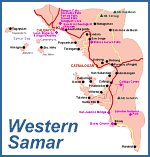
The third largest island in the Philippines and the largest among the three Samar provinces, Western Samar or Samar province lies in the southwestern part of Samar Island. Surrounded by Northern Samar on the north, Eastern Samar on the east, Samar Sea on the west and Leyte Gulf on the south.
Samar was previously called Zamal, Ibabao, Achan and Tandaya. The legends told that when the Spanish sailed in the province, they have encountered a wounded man and asked him the name of the place. The man did not understand Spanish and thought that they were asking what happened to him and say "samad" which means wounded in the local language. The mariner kept the name for the island but change the last letter, making Samad to Samar.
The island is mainly an agricultural province. Coconuts, rice, corn and abaca are their major crops. Other industries include mining, jellyfish processing and logging. The province also holds a large reserve of marble.
Samareņos are also into fishing business, the seas enveloping the province are good fishing grounds. Samar is famous for their dried fish and other marine products. The town of Calbayog is noted for its tinapa or smoked fish.
Women of the province are known for their skill in weaving. Tikog, a perplexed designed mat made from grass sedge, are among the most respected traditional crafts in the country.
Samareņos have the liking in celebrations and other cultural events. Balitaw, a Visayan courting song is widely popular in the province. The lyrics are set in rhymes and are sung by pairs of men and women.
Samar is noted for its variety of natural attractions. Blanca Aurora, Pan-as, Ton-ok and Darosdos are some of the breathtaking falls found in the island. Calbiga Cave is marked to be one of the largest in the world, while Guinogo-an and Tinago-an Caves also attract travelers. Some of their best beaches are Lo-oc, Bagakay and Naga.
Access to the province can be done by air or by land. PAL flies regularly from Manila to Calbayog airport. By bus coming from Visayas one has to travel the San Juanico Bridge to Tacloban City and coming from Luzon the route via Allan.
|